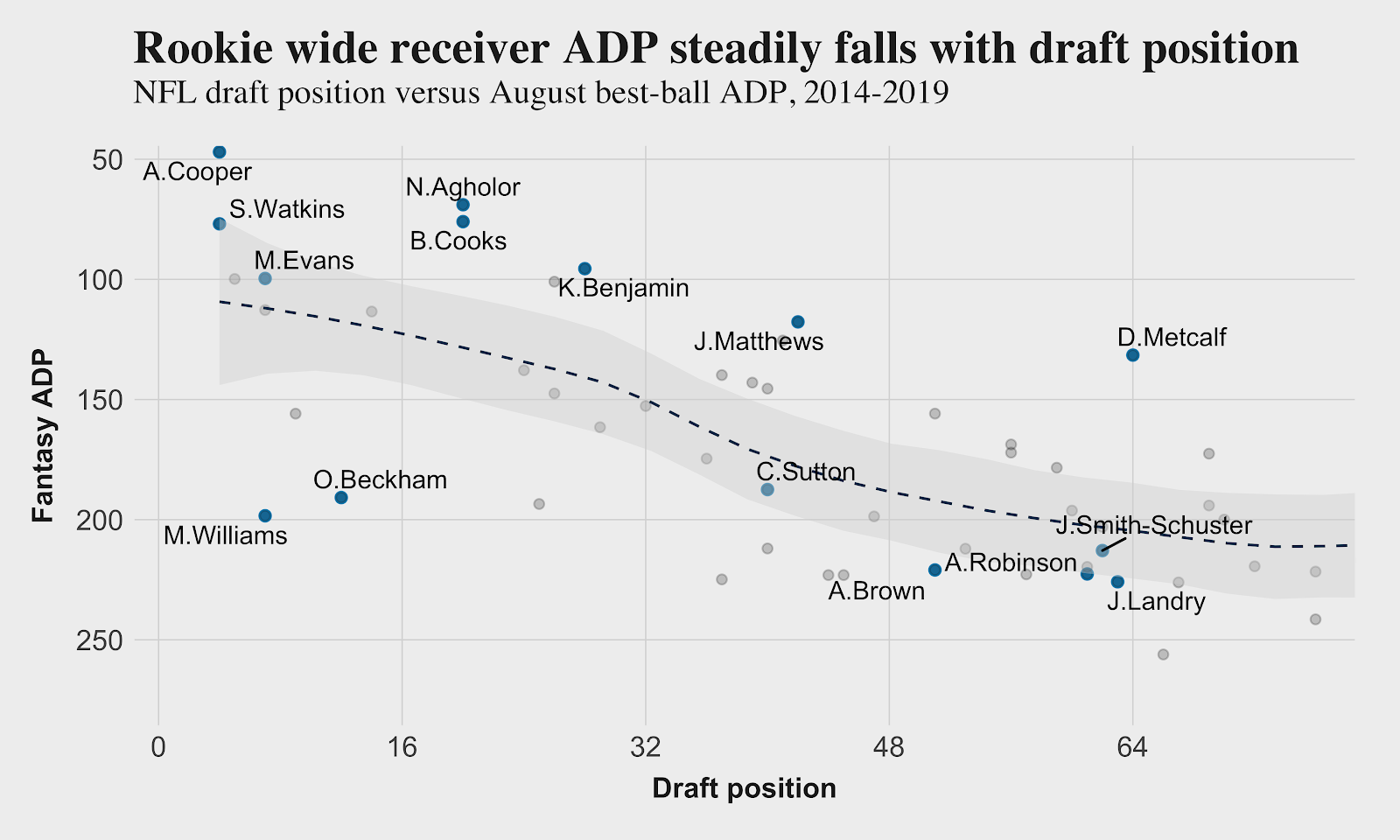The last few weeks, I’ve been digging through early offseason best ball ADP data to find players whose values have shifted the most through free agency, how 2020 prospects are viewed versus past classes, the differences in positional rankings between our projections and market sentiment, and the best landing spots for rookie wide receivers and running backs. Now I want to see what the relationship between draft position and fantasy ADP can tell us about player value.
There will always be disconnects between the fantasy world and “real” football value, some for understandable reasons, others not. A low-volume, field-stretching receiver will have more worth on NFL draft boards than fantasy leagues, whose drafters are concerned with individual stats and not affecting a defense. Even understanding those logical differences, there are often other, less-easily explained disagreements in valuation between the fantasy and draft communities that can tell us where a player is overvalued or undervalued by either party.
[Editor’s note: Check out PFF’s 2020 Mock Draft Hub, NFL Draft Big Board and NFL Mock Draft Simulator. PFF Elite subscribers can also download the 1,100-page 2020 NFL Draft Guide.]
The relationship between fantasy ADP and reality draft position is fairly strong and linear, and in this article I’ll walk through seven years of fantasy football historical data and build a valuation curve between the two. We can see when, in the past, fantasy drafters have been too low on a player who went earlier in the NFL draft, and vice versa. Each can probably learn from each other, with NFL teams having more data and knowledge of prospects and fantasy football leagues providing the wisdom of crowds combining thousands of individual opinions into one valuation.
HISTORICAL WIDE RECEIVER CURVE
In the plot below, I charted the actual NFL draft position against fantasy ADP leading into the season (August of the respective year) for each rookie taken. I highlighted names of some productive rookies who helped win fantasy leagues for whomever drafted them, and others with large deviations in value from the trend line.

No fantasy rookie has gone higher than Amari Cooper in recent fantasy drafts, a logical outcome as the No. 4 overall pick in 2015 on the heels of highly productive 2014 rookie outputs. Among picks who were undervalued versus ADP but taken in the top half of the first round, Mike Williams and Odell Beckham Jr. stand out, the latter one of the most impactful rookie fantasy players ever. Williams’ and Beckham’s ADPs were primarily driven down by injury concerns, and both missed time to start the season. Other undervalued players who went later in the NFL draft, like Jarvis Landry, A.J. Brown and JuJu Smith-Schuster, were highly successful as rookies.
The players who fantasy drafters expected the most from in comparison to draft position were mostly hit-or-miss in actual production. Cooper, Mike Evans and Kelvin Benjamin were WR1s on their respective teams, while others like Sammy Watkins and Nelson Agholor struggled with injury or ineffective play.
THE 2020 WIDE RECEIVERS
For the 2020 class, I’m using expected draft positions from GrindingTheMocks, which uses publicly available mock draft data in a regression to determine when players are likely to be picked. The fantasy ADPs are taken from best ball leagues over the last two weeks.

The distinct trend, outside of top dogs Jerry Jeudy and CeeDee Lamb, is an undervaluation of 2020 rookie wide receivers versus their expected draft position. One of three things is happening: mock drafters are overvaluing rookie wide receivers; fantasy drafters don’t realize how early these guys are going to be drafted; or fantasy players have been hip to the lower value of rookie wide receivers after years of disappointments. The expected draft positions have six wide receivers going in the first round and three more in the top-half of the second round.
Jalen Reagor, in particular, is more highly valued by the fantasy community than its draft counterparts, going earlier than Denzel Mims and Tee Higgins despite a lower expected draft position. The other side of the coin: Players like Brandon Aiyuk and Michael Pittman could fly up fantasy boards if they go even slightly higher in the real draft than expected, especially to favorably viewed landing spots.
The best fantasy strategy this offseason leading into the draft could be to invest heavily in rookies outside of the top two, with fantasy markets late to recognize how early the class is expected to go in the NFL draft.
[Find a full collection of analysis and insights on PFF's 2020 fantasy football projections for all 32 NFL teams.]



 © 2025 PFF - all rights reserved.
© 2025 PFF - all rights reserved.